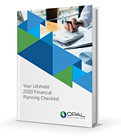How Transferable Is Your Business?
By Lee Korn | May 15, 2019You’ve invested the time and energy into building your business and are now reaping the benefits of its success—it’s the ultimate goal of any business owner. But for many entrepreneurs, their long-term horizon points toward ultimately selling part or all of the business for a profit.
Of course, the likelihood of executing a healthy exit strategy has everything to do with the transferability of your business. In other words, is your business set up in a way that someone new could step in your place and take the reins relatively easily? How you answer should give you a good indication of whether or not you’ll attract worthwhile potential buyers.

Paying Attention to Value Drivers
Think of value drivers as the details prospective buyers are zeroing in on when considering whether or not to go through with an acquisition. Put it another way: What is your business worth to them as a long-term investment? The first side of the coin is positive cash flow. If your company is still working out the growing pains of infancy, you’re probably not positioned for a smooth exit.
The other part of the equation is stability when exiting during a time of growth. (We’ll dive into this in a moment.) When all is said and done, is your business on a reliable track to continue not only meeting its goals, but growing? Buyers are looking for some sort of reassurance that the business is moving in an upward trajectory in terms of revenue.
Scalability certainly comes into play. As sales hopefully continue on an upswing, is your company equipped to boost its profit margins? Take a look at your current operating systems and management team to better predict how your business will continue thriving once you’re out the door.
Exiting Through Growth
The best case scenario is to be exiting during a time of business growth, which buyers interpret as stability. Mentally checking out is the last thing you want to do when courting new business partners. Instead, you want to continue investing your attention and resources into your company’s longevity. You’re still all in. The only difference is that you’re putting systems in place so that the business can continue chugging along smoothly once you’re gone.
It’s a task that requires putting a lot of focus into your management team. Who will continue running day-to-day operations in your absence? Is executive leadership in place that shares your business vision and core values? To put it simply, the less stable these things are, the less transferable your business is.
A key part of a well-executed exit strategy is making a plan for how your management team will continue functioning. Think about which tasks you’ll be delegating and to whom. Does your plan necessitate any formal trainings or workshops? And, most importantly, are your employees up to the task?
Will Your Business Attract Valuable Buyers?
Let’s say that after careful consideration, you’ve determined that your business is indeed transferable. Now what? Before you begin crafting your exit strategy, you need to have a firm grasp on what your company is reasonably worth. This involves not only understanding where your current value is, but also identifying where it falls short.
It’s the foundation of optimizing growth and performance, and ultimately increasing your business’s transferability. At Opal Wealth Advisors, our Business Valuation Tool leverages data-driven methodology to provide individualized business insights that include crafting a comprehensive and effective exit strategy.
The time and energy you invest in this part of the game is just as important as all you’ve put into building your business from the ground up. Whether or not your business is transferable could
very well make or break your acquisition options.
Be a Smart Investor
Stay up-to-date with industry-leading information and news delivered straight to your inbox.
Get our timely insights delivered to your inbox (Blog)
Please remember that past performance may not be indicative of future results. Different types of investments involve varying degrees of risk, and there can be no assurance that the future performance of any specific investment, investment strategy, or product (including the investments and/or investment strategies recommended or undertaken by Opal Wealth Advisors, LLC [“OWA]), or any non-investment related content, made reference to directly or indirectly in this commentary will be profitable, equal any corresponding indicated historical performance level(s), be suitable for your portfolio or individual situation, or prove successful. Due to various factors, including changing market conditions and/or applicable laws, the content may no longer be reflective of current opinions or positions. Moreover, you should not assume that any discussion or information contained in this commentary serves as the receipt of, or as a substitute for, personalized investment advice from OWA. OWA is neither a law firm, nor a certified public accounting firm, and no portion of the commentary content should be construed as legal or accounting advice. A copy of the OWA’s current written disclosure Brochure discussing our advisory services and fees continues to remain available upon request or at www.opalwealthadvisors.com. Please Remember: If you are a OWA client, please contact OWA, in writing, if there are any changes in your personal/financial situation or investment objectives for the purpose of reviewing/evaluating/revising our previous recommendations and/or services, or if you would like to impose, add, or to modify any reasonable restrictions to our investment advisory services. Unless, and until, you notify us, in writing, to the contrary, we shall continue to provide services as we do currently. Please Also Remember to advise us if you have not been receiving account statements (at least quarterly) from the account custodian.



